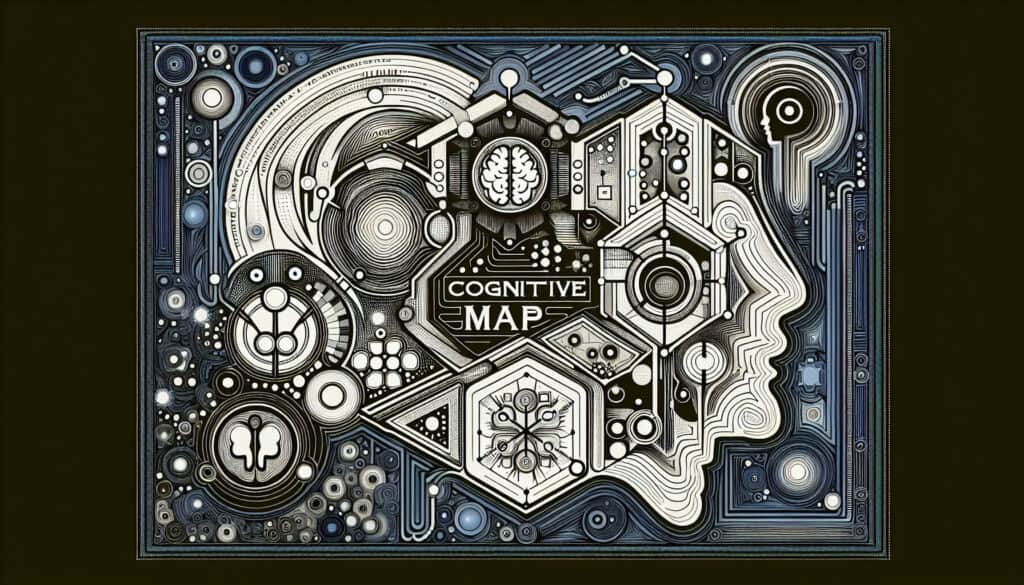A type of mental representation which serves an individual to acquire, code, store, recall, and decode information about the relative locations and attributes of phenomena in their everyday or metaphorical spatial environment.
- Methodologies: Customers & Marketing, Economics, Lean Sigma, Manufacturing, Project Management, Quality
Cognitive Map

Cognitive Map
- Cognitive Computing, Customer Journey Mapping, Design Process, Design Thinking, Human-Centered Design, Interaction Design, User experience (UX), User Interface (UI), User Testing
Objective:
How it’s used:
- In design and research, it's a visualization tool used to represent a person's mental model of a particular concept or process, often looking like a network or web diagram.
Pros
- Helps to understand a user's mental model and thought processes, can reveal misconceptions or opportunities for better design, and provides a rich, qualitative view of a user's understanding.
Cons
- Can be complex and time-consuming to create and analyze, the interpretation can be subjective, and it represents one person's perspective which may not be generalizable.
Categories:
- Ideation, Problem Solving, Product Design
Best for:
- Visualizing and understanding a person's mental model of a system, concept, or process.
Cognitive mapping is widely applied in industries such as user experience design, education, and healthcare for understanding complex processes and enhancing user interactions. In the early stages of product development or research, this methodology is often initiated by designers, researchers, or product managers who seek to align their understanding of user needs with their product goals. It allows teams to visualize cognitive structures and reveal hidden assumptions about how users interact with a system, thereby informing design decisions and identifying potential areas for improvement. In educational contexts, instructors might use cognitive maps to help students organize and relate information, enhancing learning outcomes. In software development, cognitive maps can be beneficial during user testing phases, allowing developers to track where users might experience confusion or frustration. This technique can be implemented in workshops or collaborative sessions, where participants collectively build and share maps to merge their individual perspectives into a cohesive understanding of the challenges and opportunities within a system. By leveraging this qualitative approach, teams not only gain a deeper comprehension of user behaviors and scenarios but also strengthen communication and collaboration among stakeholders in the design process.
Key steps of this methodology
- Identify the system, concept, or process to be mapped.
- Generate key concepts and components relevant to the topic.
- Define relationships between the concepts, including cause-effect linkages.
- Create a visual representation, organizing the concepts hierarchically or thematically.
- Iteratively refine the cognitive map based on feedback and evaluation.
- Analyze the cognitive map for patterns, misconceptions, and opportunities.
Pro Tips
- Incorporate grounded theory techniques during cognitive mapping sessions to capture emerging themes and relationships in user data.
- Utilize software tools that allow real-time collaboration and iteration of cognitive maps for enhanced stakeholder feedback.
- Apply scenario-based analysis alongside cognitive maps to address how different mental models influence user decisions in specific contexts.
To read and compare several methodologies, we recommend the
> Extensive Methodologies Repository <
together with the 400+ other methodologies.
Your comments on this methodology or additional info are welcome on the comment section below ↓ , so as any engineering-related ideas or links.
Historical Context
1848
1850
1854
1895
1914
1943
1970
1828
1850
1854
1854
1911
1928
1950
1980
(if date is unknown or not relevant, e.g. "fluid mechanics", a rounded estimation of its notable emergence is provided)















Related Posts
Musculoskeletal Discomfort Questionnaires
Multivariate Testing (MVT)
Multiple Regression Analysis
Motion Capture Systems
MoSCoW Method
Mood’s Median Test